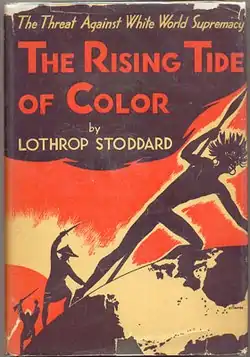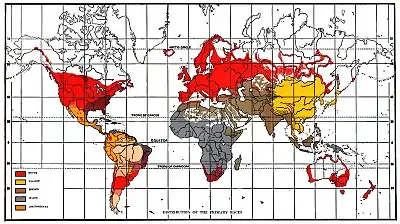The Rising Tide of Color Against White World-Supremacy
The Rising Tide of Color: The Threat Against White World-Supremacy (1920), by Lothrop Stoddard, is a book about racialism and geopolitics, which describes the collapse of white supremacy and colonialism, because of the population growth among people of color, rising nationalism in colonized nations, and industrialization in China and Japan. To counter the perceived geopolitical threat, Stoddard advocated restricting non-white migration into white countries, by restricting Asian migration to Africa and Latin America, and slowly giving independence to the Western colonies in the Middle East and Asia. A noted eugenicist, Stoddard supported a separation of the "primary races" of the world and warned against miscegenation, the mixing of the races.
 First edition, 1920 | |
| Author | Lothrop Stoddard |
|---|---|
| Country | United States |
| Language | English |
| Subject | Geopolitics, racial theory |
| Publisher | Charles Scribner's Sons |
Publication date | 1920 |
| Media type | |
| Pages | 320 (1st edition) |
| OCLC | 1572150 |
| 323.1 | |
| LC Class | HT1521 .S7 |

Release and reception
The Rising Tide sold well and The New York Times published a positive editorial on the work. In 1921, President Warren Harding used the book to support his pro-segregation views in a speech to an audience of over one-hundred thousand in Birmingham, Alabama: "Whoever will take the time to read and ponder Mr. Lothrop Stoddard’s book on The Rising Tide of Color ... must realize that our race problem here in the United States is only a phase of a race issue that the whole world confronts."
Conversely, "Father of American Anthropology" Franz Boas was negative towards the work and Stoddard was called "the high priest of racial baloney" by African-American newspapers.[1]
The book continued to influence the white supremacist movement in the United States in the early 21st century.[2]
In popular culture
In the novel The Great Gatsby (1925), by F. Scott Fitzgerald, the antagonist character, Tom Buchanan, speaks approvingly of the racialism presented in a book titled The Rise of the Colored Empires, written by a man named Goddard, which is a fictional reference to Stoddard and his book using a portmanteau name blended with the "G" of Madison Grant, a colleague.[3][4]
See also
References
- Frazier, Ian (2019-07-26). "When W. E. B. Du Bois Made a Laughingstock of a White Supremacist". The New Yorker. Retrieved 2019-08-30.
- Berlet, Chip; Vysotsky, Stanislav (2006). "Overview of U.S. White Supremacist Groups". Journal of Political and Military Sociology. 34 (1): 14.
- Carter, Stephen. "What 'Great Gatsby' Can Teach Millennials". Bloomberg View. Retrieved 5 August 2015.
- Hsu, Hua. "The End of White America?". The Atlantic. Retrieved 5 August 2015.
External links
- The Rising Tide of Color Against White World-Supremacy (1922 ed.) via Google Books ISBN 4-87187-849-X
- The Rising Tide of Color at Project Gutenberg
- Library of Congress catalog entry